| Chapter 2 The Video Vicarage Prime Time Preachers: The Rising Power of Televangelism | ||
THE RISING STARS
Styles change in television, and stars come and go. The electronic church can
hardly be exempt from this fact of TV life, but since the programs are not so
directly dependent on audience size as secular entertainment programs, the stars
who fade away probably will do so in the Lawrence Welk style of gradual
attrition. But for all who may be in decline or nearing retirement, there are
others waiting in the wings for their period of stardom. There are three
televangelists who are positioned to make a run for the big time. To succeed,
they have to raise the money to pay for their telecasts, and they have to find
time that can be purchased on an already crowded schedule. Since the way they
pay for time is to get on the air and raise the money, this could prove to be a
real
James Robison
Robison is one of God's angry men. He thunders from the pulpit against all manner of immorality, sinfulness, vice, unAmericanism, and secular humanism. The thirty-seven-year-old Robison has been an evangelist for eighteen years and has been on television since 1970. He is a truly dynamic preacher of seemingly inexhaustible energy. His dynamism reminds some of Billy Graham when he was younger. Although Robison's television ministry has not grown as rapidly as others, he stands on the threshold of becoming a major television preacher. His program, "James Robison, Man with a Message," is syndicated on sixty-four U.S. television stations.
Robison is the product of a broken home. His alcoholic father deserted his mother before James (never Jim) was born in a charity ward in Houston. His mother placed a newspaper advertisement offering her infant to whoever would give him a home. A minister and his wife responded, and James grew up with them. Later attempts at reunions with his father and mother had unhappy results. Saved al age fifteen, Robison attended school briefly at East Texas Baptist College in Marshall. By age nineteen he had received hundreds of invitations to conduct revival meetings. This heavy schedule of evangelism interfered with completion of a formal education.
One of Robison's several crusades is against homosexuality, and one of his attacks on gays got his program canceled by a Dallas TV station. When the Dallas Gay Political Caucus asked for equal time under the FCC's Fairness Doctrine, station WFAA decided that Robison's program was simply too much trouble. But when Robison drew 10,000 people to a "freedom rally" and retained Houston attorney Richard "Racehorse" Haynes to press a hearing before the FCC, the television station decided to reinstate his program.
Robison calls things the way he sees them, and there are few
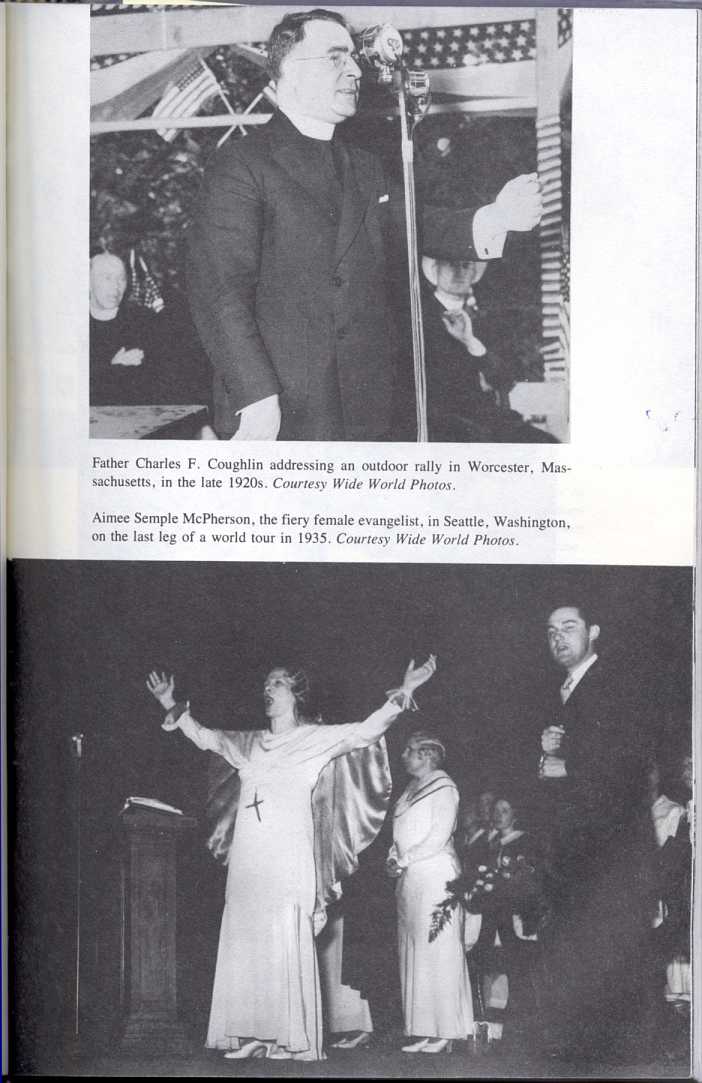
Father Charles F. Coughlin addressing an outdoor rally in Worcester,
Massachusetts, in the late 1920s. Courtesy Wide World Photos.
Aimee Semple McPherson, the fiery female evangelist, in Seattle, Washington,
on the last leg of a world tour in 1935. Courtesy Wide World Photos.
[Description:
Two black and white photos: first, Father Charles F. Coughlin addressing
an outdoor rally in Worcester, Massachusetts, in the late 1920s; second,
Aimee Semple McPherson, the fiery female evangelist, in Seattle,
Washington, on the last leg of a world tour in 1935.
]
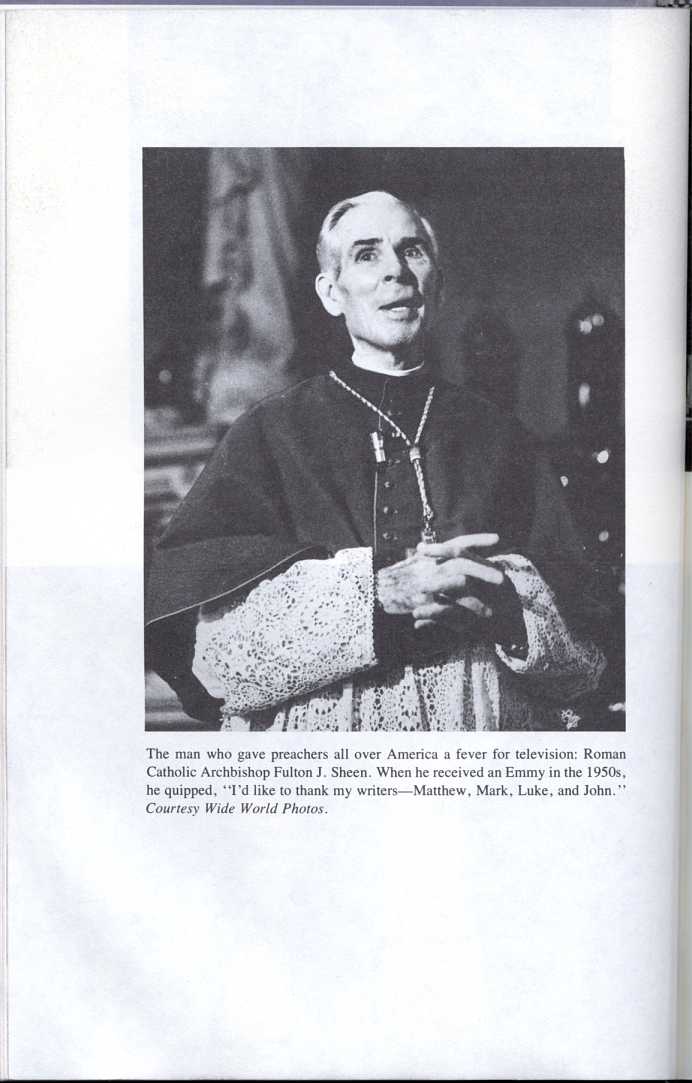
The man who gave preachers all over America a fever for television: Roman Catholic Archbishop Fulton J. Sheen. When he received an Emmy in the 1950s, he quipped, "I'd like to thank my writers—Matthew, Mark, Luke, and John. " Courtesy Wide World Photos.
[Description: Black and white photo of Roman Catholic Archbishop Fulton J. Sheen. ]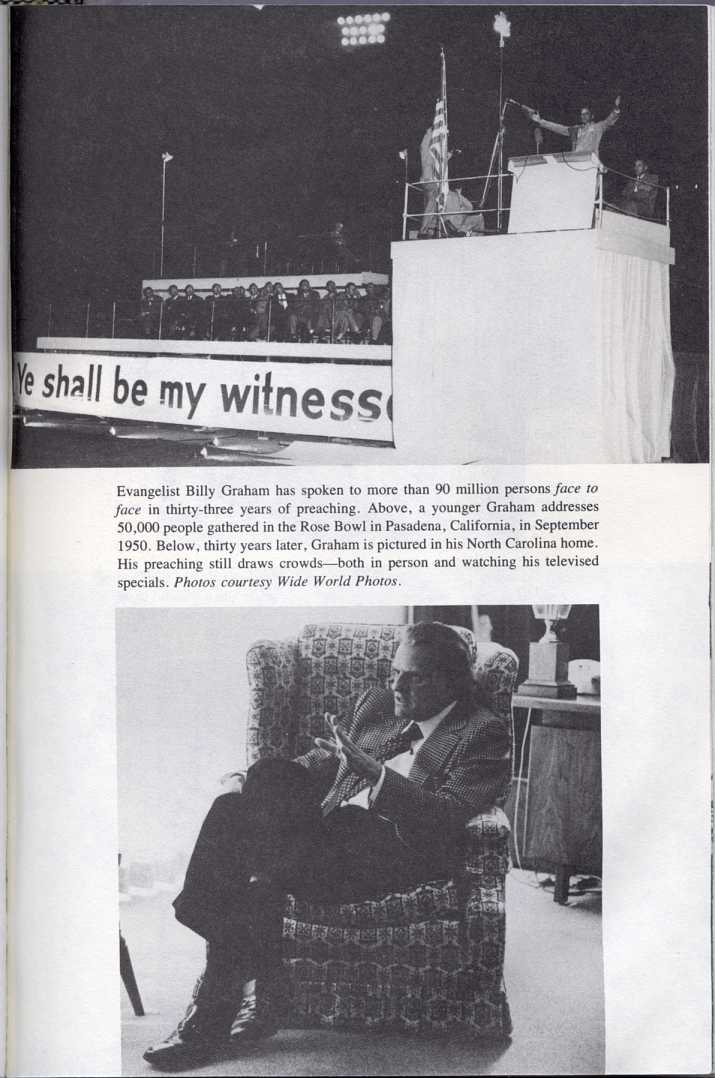
Evangelist Billy Graham has spoken to more than 90 million persons
face to face in thirty-three years of preaching. Above, a younger
Graham addresses 50,000 people gathered in the Rose Bowl in Pasadena,
California, in September 1950. Below, thirty years later, Graham is
pictured in his North Carolina home.
His preaching still draws crowds-both in person and watching his televised
specials. Photos courtesy Wide World Photos.
[Description:
Top photo (black and white): Billy Graham at the podium during a crusade.
Bottom photo (black and white): an older Graham in an easy chair.
]
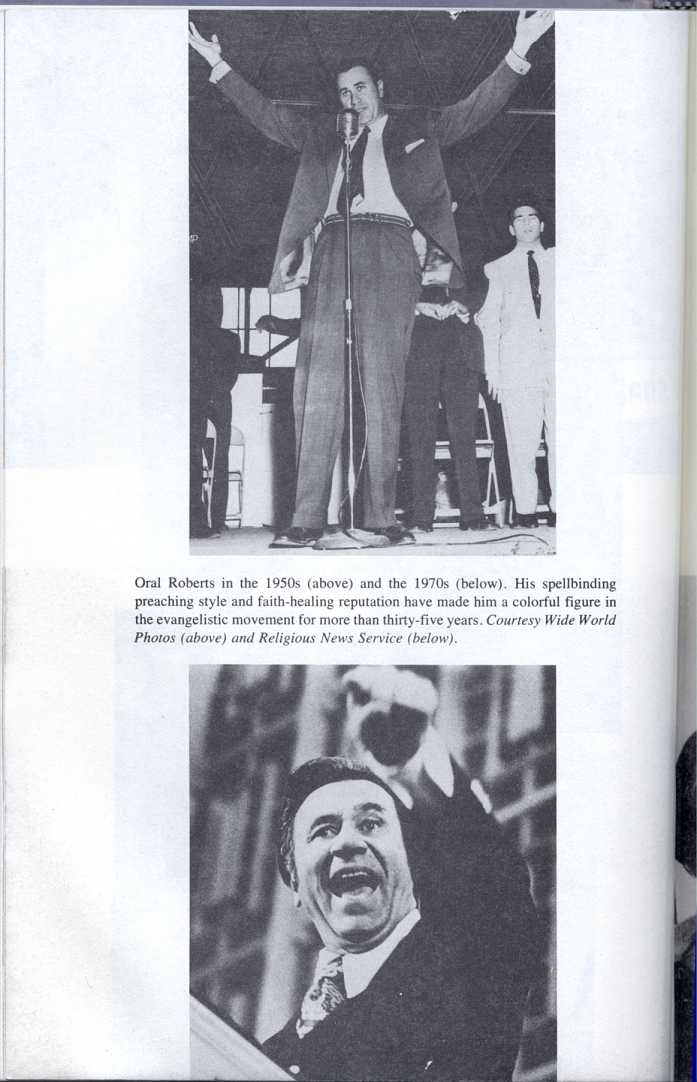
Oral Roberts in the 1950s (above) and the 1970s (below). His spellbinding preaching style and faith-healing reputation have made him a colorful figure in the evangelistic movement for more than thirty-five years. Courtesy Wide World Photos (above) and Religious News Service (below).
[Description: Two black and white photos of Oral Roberts in the 1950s (above) and the 1970s (below). ]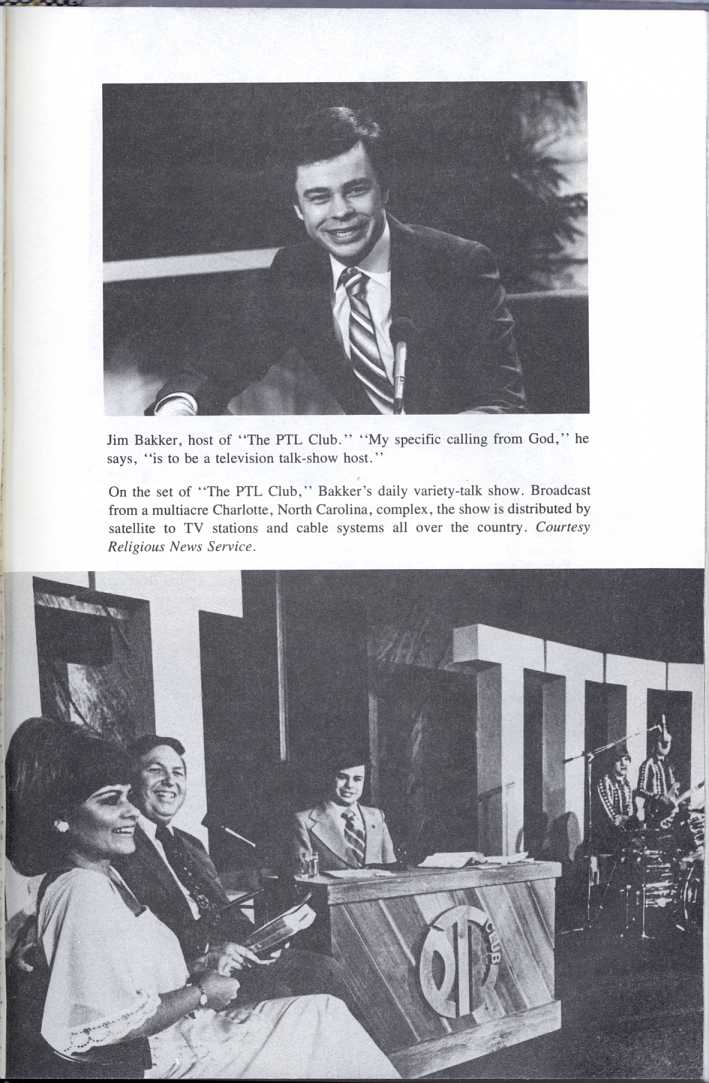
Jim Bakker, host of "The PTL Club." "My specific calling
from God," he says, "is to be a television talk-show host."
On the set of "The PTL Club", Bakker's daily variety-talk show.
Broadcast from a multiacre Charlotte, North Carolina, complex, the show is
distributed by satellite to TV stations and cable systems all over the country.
Courtesy Religious News Service.
[Description:
Two black and white photos of Jim Bakker sitting at the desk of the P.T.L. set.
]
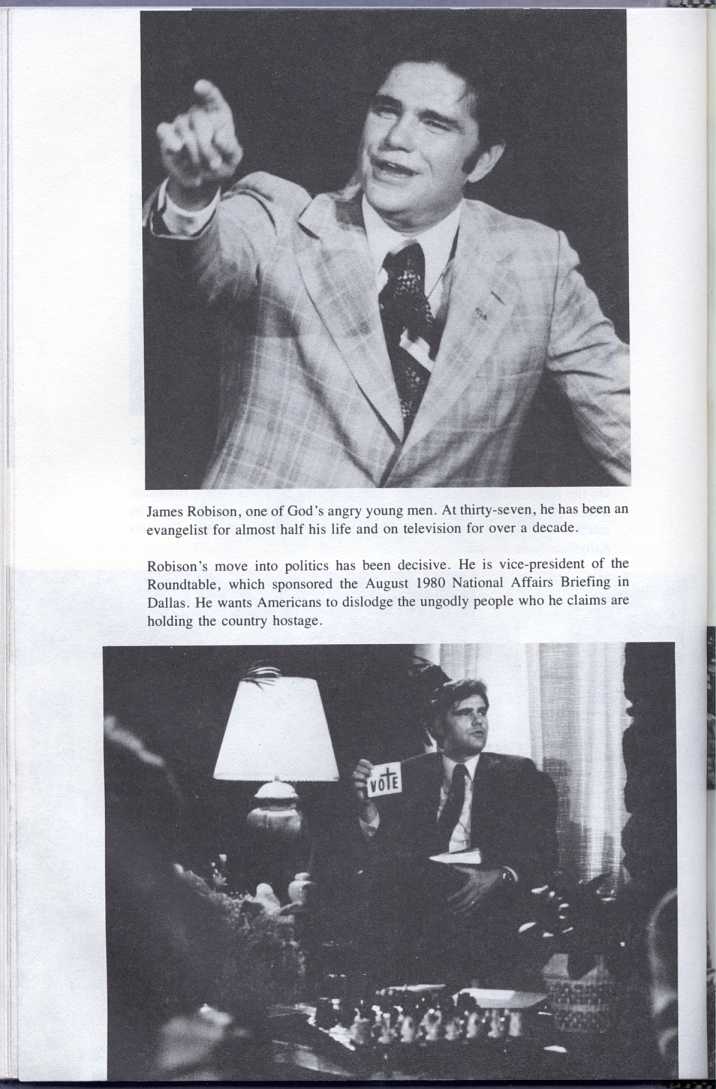
James Robison, one of God's angry young men. At thirty-seven, he has been an
evangelist for almost half his life and on television for over a decade.
Robison's move into politics has been decisive. He is vice-president of the
Roundtable, which sponsored the August 1980 National Affairs Briefing in
Dallas. He wants Americans to dislodge the ungodly people who he claims are
holding the country hostage.
[Description:
Two black and white photos of James Robison.
]
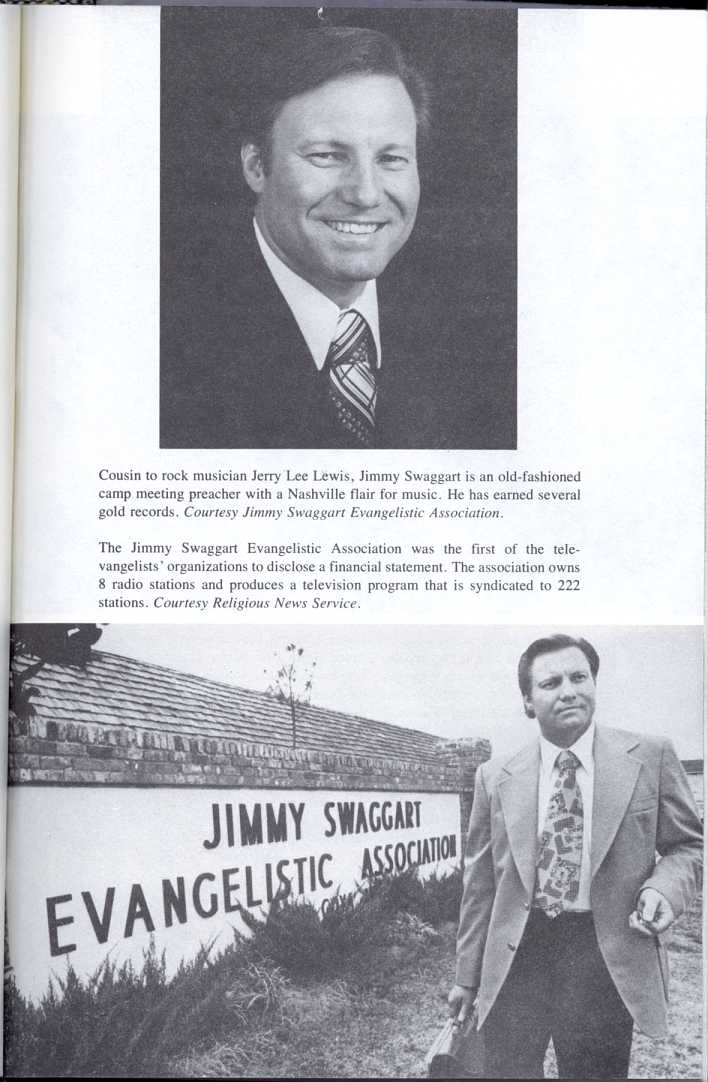
Cousin to rock musician Jerry Lee Lewis, Jimmy Swaggart is an
old-fashioned camp meeting preacher with a Nashville flair for music.
He has earned several gold records. Courtesy Jimmy Swaggart
Evangelistic Association.
The Jimmy Swaggart Evangelistic Association was the first of the
televangelists' organizations to disclose a financial statement.
The association owns 8 radio stations and produces a television
program that is syndicated to 222 stations. Courtesy Religious
News Service.
[Description:
Two black and white photos of Jimmy Swaggert, one, a formal portrait,
in the other, he walks past his ministry's sign.
]
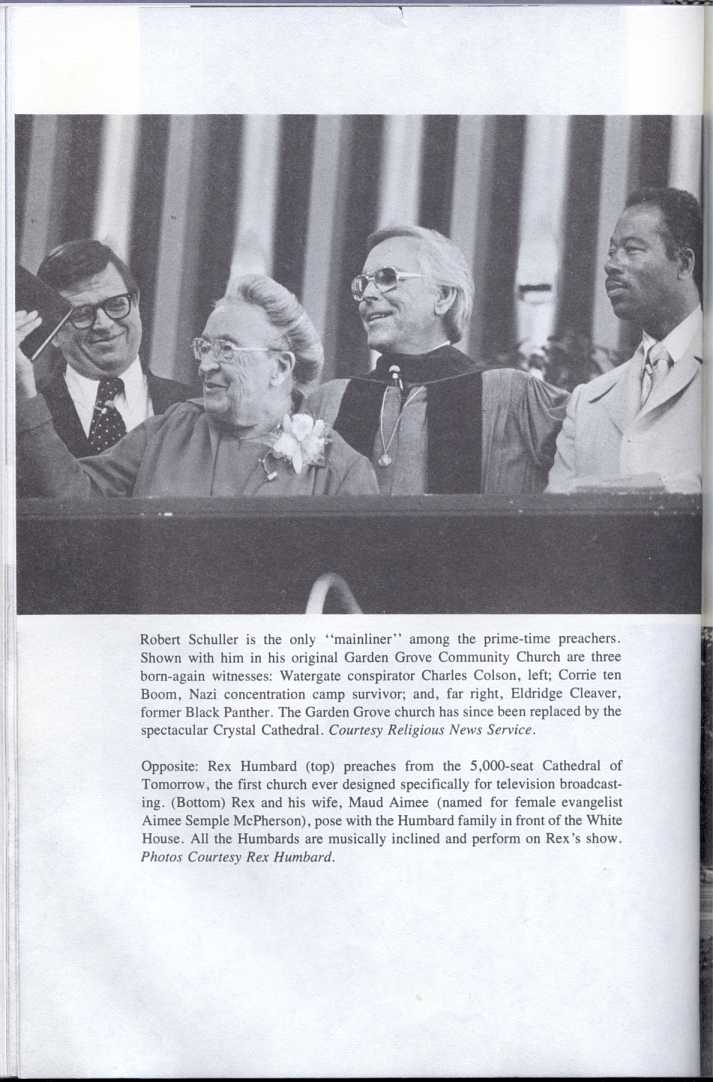
Robert Schuller is the only "mainliner" among the prime-time
preachers. Shown with him in his original Garden Grove Community Church
are three born-again witnesses: Watergate conspirator Charles Colson,
left; Corrie ten Boom, Nazi concentration camp survivor; and, far right,
Eldridge Cleaver, former Black Panther.
The Garden Grove church has since been replaced by the spectacular Crystal
Cathedral. Courtesy Religious News Service.
[Description:
Black and white photo of Robert Schuller. Shown with him in his original
Garden Grove Community Church are three born-again witnesses: Watergate
conspirator Charles Colson, left; Corrie ten Boom, Nazi concentration camp
survivor; and, far right, Eldridge Cleaver, former Black Panther.
]
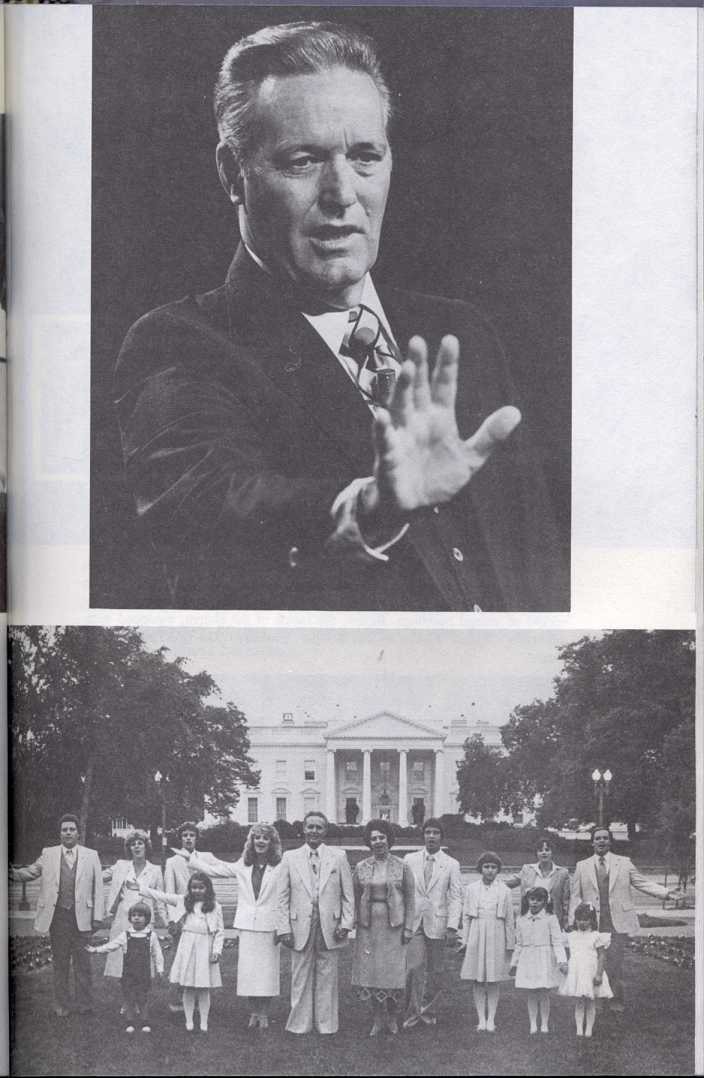
Opposite: Rex Humbard (top) preaches from the 5,000-seat Cathedral of
Tomorrow, the first church ever designed specifically for television
broadcasting.
(Bottom) Rex and his wife, Maud Aimee (named for female evangelist Aimee
Semple McPherson), pose with the Humbard family in front of the White
House. All the Humbards are musically inclined and perform on Rex's show.
Photos Courtesy Rex Humbard.
[Description:
Two photos of Rex Humbard: top he preaches from the 5,000-seat
Cathedral of Tomorrow, the first church ever designed specifically
for television broadcasting; bottom Rex and his wife, Maud Aimee,
pose with the Humbard family in front of the White House.
]
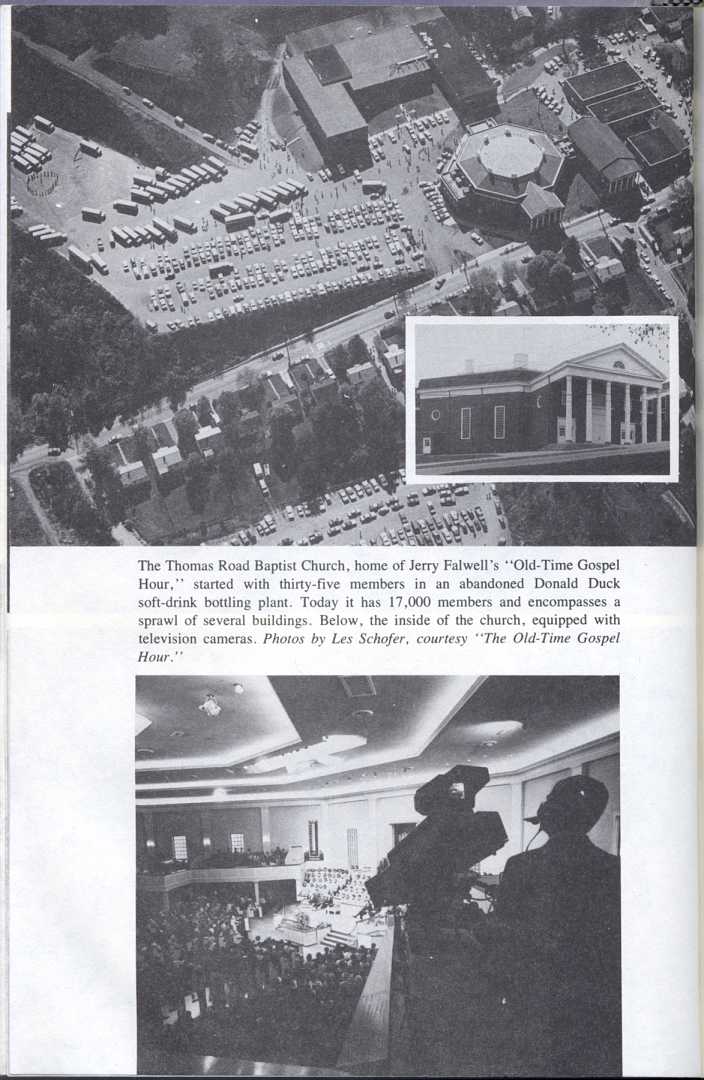
The Thomas Road Baptist Church, home of Jerry Falwell's "Old-Time
Gospel Hour," started with thirty-five members in an abandoned
Donald Duck soft-drink bottling plant. Today it has 17,000 members and
encompasses a sprawl of several buildings.
Below, the inside of the church, equipped with television cameras.
Photos by Les Schofer, courtesy "The Old-Time Gospel Hour".
[Description:
Outside aerial shot of The Thomas Road Baptist Church, home of Jerry
Falwell's "Old-Time Gospel Hour," and an interior shot.
]
He is vice-president of the Roundtable, which sponsored the National Affairs Briefing held in Dallas during August 1980. During the summer of that election year, Robison aired a television special entitled "Wake Up, America: We're All Hostages!" Robison thinks that the government has been taken over by ungodly people and that the moral people of America are being held hostage by ungodliness, secular humanism, immorality, and other un-American attributes. Appearing on the special to help spell out those ills were many figures associated with the ultraright of U.S. politics.
Some of Robison's closest associates feel his overt move into politics could hurt rather than help his chances for achieving national prominence. But Robison is anything but timid. He believes the country is in trouble, and he intends to spend every ounce of energy he has spreading God's saving grace as the answer to godless humanism.
Kenneth Copeland
Kenneth Copeland is fun to watch. He enjoys preaching. He paces up and down
the stage when speaking, and he loves to make his audience laugh. His audiences
get into the fun-filled spirit of it all—they chuckle, roar, whistle, and
applaud. Copeland loves it, and he pours on his special brand of Spirit-filled,
good-humored gospel in response. But he is not good-humored about the dead, dry
churches of the respectable mainline and the safe, sane gospel they preach. He
likes churches and people who believe in healing, speaking in tongues, expecting
miracles, and letting it all hang out for Jesus, homespun and high-powered. He
made his television ministry debut in 1979, and he is already seen on
thirty-eight stations, with more being added as fast as time can
Jack Van Impe
If you were watching Jack Van Impe during the summer of 1980, he would have
offered to send you a free book, Everything You Always Wanted to Know about
Prophecy, but Didn't Know Who to Ask! He, of course, is whom you should ask.
And you'd better get your questions answered soon, because these days are the
"end time" just before Jesus comes again. Until that actually happens,
however, all Americans must be on guard against the menace of satanic communism
in our midst.
Van Impe is the latest rising star of the electronic church. In less than a year he has managed to buy time on eighty-one stations, a truly phenomenal accomplishment. Van Impe appeals to those who are fascinated with biblical prophecy. Judging from the success of such books as Hal Lindsey's Late Great Planet Earth, there are large numbers of such people. Other religious programs have attempted to appeal to this audience, but Van Impe's is the first that meets the high standards of quality production. He uses fast-moving canned film for the opening of his show. The audience is usually entertained by his wife, Rexella, who then interviews her husband on some pressing issue. Van Impe then gives a sermon on the imminent threat of the holocaust.
If you write for whatever free book Van Impe is offering, you can expect to receive it more quickly than you receive the gifts offered on any other religious program. You'll also receive his magazine entitled Perhaps Today. Van Impe aspires to reach every TV market in the United States as soon as possible. After all, time is running out.
| Chapter 2 The Video Vicarage Prime Time Preachers: The Rising Power of Televangelism | ||